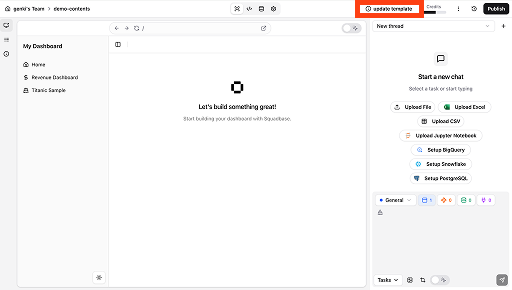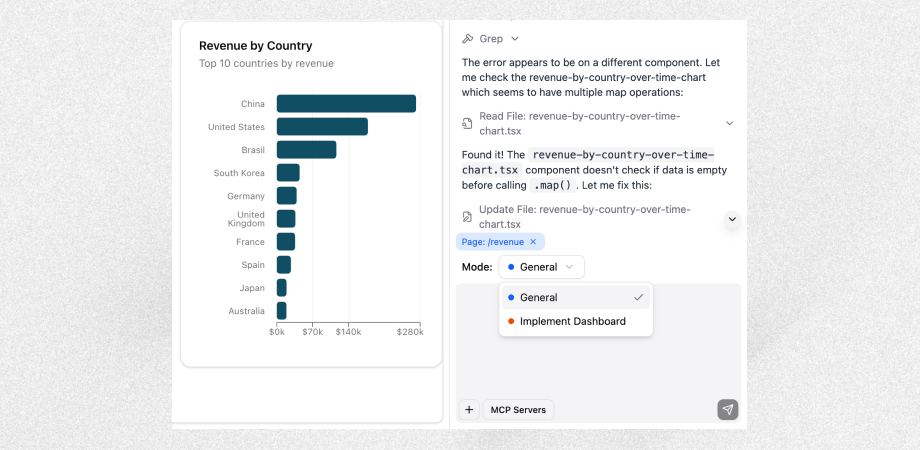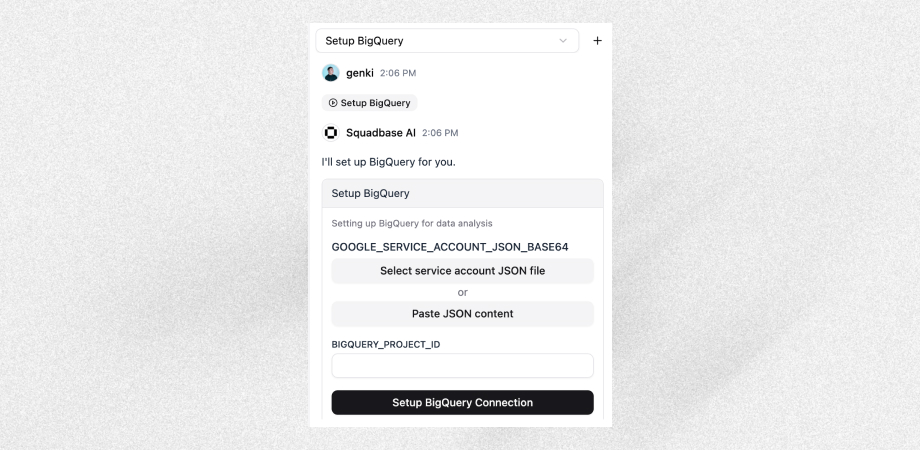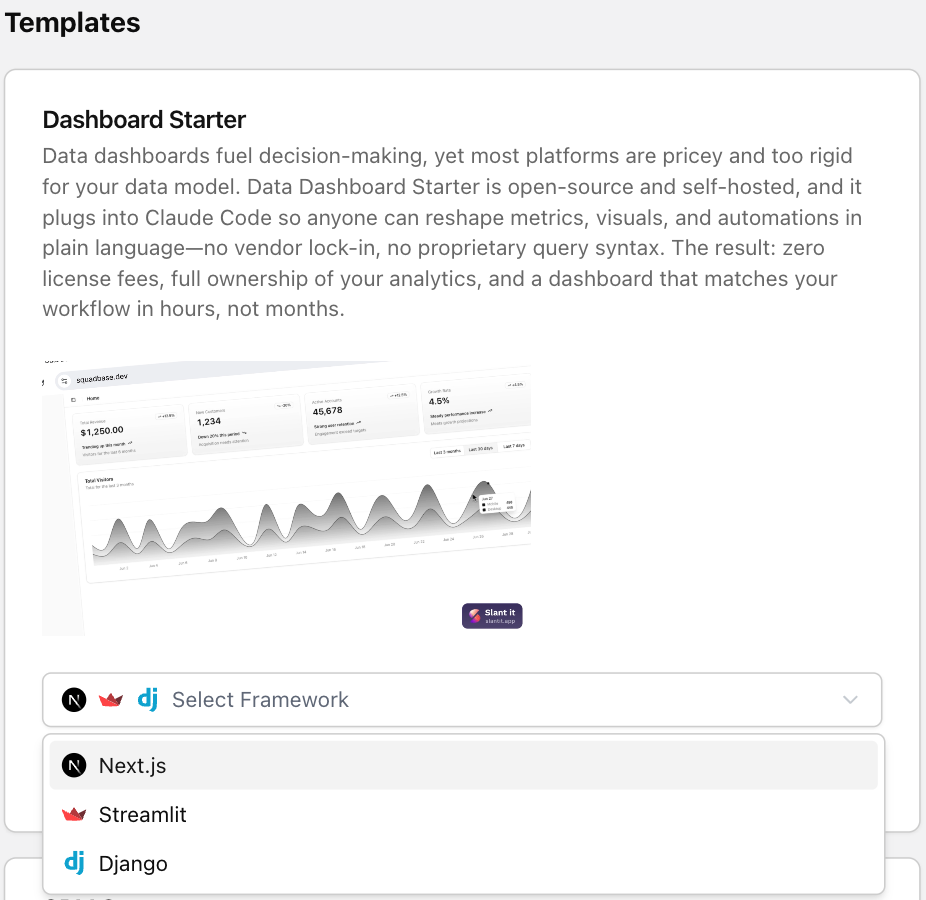Changelog
Google Analytics Connection
 Support for connecting to Google Analytics is now available.
You can set environment variables, configure the MCP server, and install required packages directly from chat, allowing you to start building dashboards immediately.
Support for connecting to Google Analytics is now available.
You can set environment variables, configure the MCP server, and install required packages directly from chat, allowing you to start building dashboards immediately.
New AI Modes
 We’ve added new AI modes that allow users to control how the AI behaves based on their goals. These modes fall into two main categories: conversational modes and task-oriented modes.
We’ve added new AI modes that allow users to control how the AI behaves based on their goals. These modes fall into two main categories: conversational modes and task-oriented modes.
Conversational Modes
-
General – A balanced mode offering strong reasoning, speed, and cost efficiency.
-
Fast – A speed-optimized mode suitable for simple tasks.
-
Thinking – A high-reasoning mode designed for complex tasks.
Task-Oriented Modes
-
Dashboard – Optimized for implementing dashboards, especially when adding pages or charts. This mode provides a strong balance of speed and cost efficiency tailored for dashboard development.
-
Excel/CSV – Designed for cleansing and preparing data from uploaded Excel or CSV files. It offers high performance and cost efficiency for spreadsheet-based data processing.
Context Management for Squadbase AI
To use these features, you will need to update your project template. Please update it via "Update template" in the toolbar.

UI Update for File Uploads
With the new UI, you can upload a file from the chat and then switch to the Data tab, where your uploaded data and your conversation with Squadbase AI are displayed side by side. This layout enables a more interactive and seamless data preparation experience.
Access Settings Directly from the Editor
 We have moved the following configuration items from the Portal screen to the Editor screen.
We have moved the following configuration items from the Portal screen to the Editor screen.
- Outbound IPs
- Git Repository
- Database
- Environments
Implement Dashboard Mode

We’ve introduced Mode as a new parameter that controls how the AI agent behaves. When sending a chat request, you can now specify a mode to tailor the agent’s actions to your goal.
This release includes the following two modes, with more coming soon:
-
General — A flexible mode suitable for a wide range of tasks. The AI agent follows your instructions to execute actions based on your prompts.
-
Implement Dashboard — Optimized for creating new dashboard pages and analytical charts. This mode streamlines everything from dashboard design to execution.
All Connections Can Now Be Configured via Chat

Previously, chat-based setup was only available for BigQuery, Snowflake, and PostgreSQL. With this update, every Connection can now be fully configured through chat, enabling a faster and more conversational workflow.
Supported connection types
Database
- MySQL
- BigQuery
- Snowflake
- PostgreSQL
AI
- OpenAI
- Anthropic
- Google AI (Gemini)
SaaS
- Hubspot
- Attio
- Stripe
- Slack
Vector Database
- Pinecone
Object Storage
- AWS S3
View the Latest Updates from the “What’s New” Panel
You can now easily stay informed about Squadbase’s latest features and improvements directly from the “What’s New” panel. Access it anytime via the bell icon in the sidebar to browse recent releases and update details.
Buy Additional AI Credits
We have also added an Auto-Charge feature that automatically purchases credits when the remaining balance reaches a configurable threshold. The threshold can be freely adjusted based on your operation needs, enabling stable usage even as team demand increases.
The Purchase History page now allows you to review and manage both manual and automatic credit purchases. Credit purchase operations can only be performed by users with Admin permissions.
Manage Key Actions from Squadbase AI Chat
You can now perform major actions—such as setting up data sources and publishing applications—from the chat interface instead of the Editor.
Additionally, when you make a natural-language request like “I want to see the time-series trend of revenue by location,” the system automatically plans and executes the entire workflow, including SQL generation and dashboard creation.
With this update, the Task feature has been removed.
Repository Switching
You can now seamlessly switch between Managed Repository (managed by Squadbase) and Linked Repository (connected to GitHub). In the Settings page, use the “Switch to Managed Repository” or “Connect to GitHub” buttons to toggle between configurations.

Component Selector
We’ve added the Component Selector, allowing you to select any component directly from the app preview and give instructions through chat.
You can now reference charts and tables on the screen as they are, making it easier to request additional analysis, modify visualizations, or inspect the underlying SQL.
Examples:
- “Add gender and age as axes to this chart and visualize it as a bar graph.”
- “Show me the SQL used in this chart.”
By interacting with components as you see them, you can enjoy a smoother and more intuitive conversational analytics experience.
Vibe Coding Platform for BI (GA)
Squadbase has become a Vibe Coding Platform for BI. All features previously offered in the Technical Preview are now generally available to all users.

Task
In data analysis workflows, ensuring the accuracy of data aggregation is critical — far more so than in typical web or app development. While creating a beautiful UI matters, verifying that the logic produces the intended results is the foundation of trustworthy analytics. This GA release introduces the Task system to support that process. Each step required for analysis is defined as an individual task, allowing users to complete the necessary validation without complex instructions for AI. By executing tasks in order, users can easily build reliable dashboards with minimal manual work.

Dashboards from Excel, CSV, and Jupyter
The GA version adds the ability to automatically generate dashboards from files such as Excel, CSV, and Jupyter notebooks. When a file is uploaded, Squadbase AI automatically preprocesses the data, prepares it for analysis, and builds the initial dashboard. Users can then update or extend the dashboard at any time using additional prompts.

Long-Term Memory and Business Knowledge
Squadbase AI now features a long-term memory system that learns and remembers business terms and context from previous user interactions. This allows users to have natural, context-aware conversations with the AI and receive insights based on accumulated knowledge. The Editor also includes an internal knowledge database that stores and refines user-specific information, enabling the AI to become more accurate and efficient the more it’s used. Through long-term memory and active communication with connected data sources via MCP, Squadbase AI autonomously plans and executes the steps required to build dashboards.

Free Viewer Licenses
Vibe Coding aims to empower everyone to become a dashboard creator. We believe that anyone involved in business decision-making should be able to explore and understand data directly. To support this vision, Viewer licenses are now free.This change allows dashboards created by teams to be shared more widely across organizations, promoting truly data-driven decision-making at every level.
Vibe Coding Platform for BI (Technical Preview)
Vibe Coding Platform for BI is now available as a Technical Preview, introducing a new way to “build dashboards with words.” This release adds the Editor, enabling users to connect data and create dashboards directly through natural language prompts..
Editor
The new Editor enables end-to-end dashboard creation and sharing directly in the browser. Squadbase AI builds dashboards in real time using leading frameworks such as Next.js, Streamlit, and Django. Users can view the process live, give additional instructions, and make adjustments as the dashboard is generated. No local development setup is required — dashboards can be collaboratively created, updated, and securely shared with the team in one click.

Data Connections and MCP Integration
The Editor includes pre-defined connectors for major SaaS applications and databases, allowing data to be fetched in real time. Through integration with the MCP server, the AI deeply understands each data structure and automatically generates high-accuracy SQL based on prompt instructions. This enables instant visualization and analysis without the need to manually specify data schemas or query details.

Official Django Support
Django is now officially supported on Squadbase. Django is one of the most powerful and popular choices for building rich web applications in Python. With Squadbase, deploying a Django app takes just a single configuration file.
Here is an example of squadbase.yml for Django.
# squadbase.yml
version: '1'
build:
framework: django
runtime: python3.11
package_manager: uv
entrypoint: my_project.asgi:applicationDjango Dashboard Starter Template
Along with official support, we’ve also added a Django starter template to help you quickly get started building dashboards on Squadbase.

App Templates Released - Multiple Updates
App Templates Released
We’ve added CRM Starter / Dashboard Starter templates to make it easier to start new projects.
Both Next.js and Streamlit starter templates are available. From the dashboard, you can select a template, automatically clone it to your GitHub repository, and deploy to Squadbase in one step.
More frameworks and template types will be added over time.

Build & Deploy Settings from the GUI
Previously, build and deployment settings had to be configured by writing a squadbase.yml file.
With this update, you can now manage build and deployment settings directly from the Setting tab of each project page in the dashboard.
This allows you to configure frameworks and cloud settings without preparing a YAML file.

Email Notifications for Deployments & Invitations
We’ve added email notifications for important Squadbase events to help you stay on top of your projects.
Notifications are sent when:
- A deployment is triggered by a Git push
- A deployment succeeds or fails
- You are invited to a project
You can manage these notifications from your account settings.

Deprecation of Connection Feature for Morph
As previously announced, the Connection feature (Project > Settings) has been deprecated in this release.
The dashboard entry points have been removed, and new connections can no longer be created via the UI.
However, existing APIs remain available for current users.
Microsoft Entra ID login is now available.
In addition to GitHub, Google accounts, and email login, you can now sign in with your Microsoft account.
This makes Squadbase easier to use in enterprise environments and ensures secure login aligned with your organization’s account management policies.

One-click deploy with the “Deploy to Squadbase” button
We’re excited to announce the new Deploy to Squadbase button, which lets you deploy any GitHub repository with a single click. One press handles the entire flow—clone, build, set environment variables, and go live on Squadbase. OSS maintainers can spin up instant sandboxes for newcomers, while internal teams can share apps with non-engineers without ever touching the CLI.
Snippets
You can add various URL query parameters to the Deploy to Squadbase button to control and customize the deployment experience for users, depending on your project's requirements.
Use the snippets below in your Git repositories or your dashboards for users to deploy.
[](https://app.squadbase.dev/new/clone?repository-url=https://github.com/username/repo-name)Highlights
- Drop a single markdown / HTML badge into a README, blog, or dashboard
- Configure the user flow with URL parameters such as
project-name,subdomain,env-var-keys,root-path, andconfig-path - Works with monorepos and private repositories accessible to Squadbase
- Ideal for OSS demos or sharing internal tools with non-engineers
→ For the full parameter list and advanced options, see the developer docs.
API Key Authentication & Official FastAPI Support
Squadbase now supports API Key authentication for accessing your deployed applications. Previously, while we supported secure app publishing by safely authenticating full-stack frameworks like Streamlit and Next.js, implementing server-side applications with frameworks such as FastAPI required separate deployments to AWS or Google Cloud. This was a challenge because it prevented users from fully benefiting from Squadbase's deployment experience when they wanted to use common backend processes across multiple applications.
This new feature makes it possible to extract common processes into server-side applications, enabling teams to operate larger-scale applications.
- Access to applications via API Key
- Official support for FastAPI as a framework in
squadbase.yml
Of course, deployments using Dockerfiles still allow for the deployment of other server-side frameworks and API Key access.
See the resources below for more details:
squadbase.yml for FastAPI
# squadbase.yml
version: '1'
build:
framework: fastapi
runtime: python3.11
package_manager: uv
entrypoint: main:appHow to Create and Access API Keys
Creating API Keys is straightforward through the Squadbase dashboard. When you create an API Key, you can specify the teams and projects it can be used with in detail. Since you can issue multiple API Keys for a single account, managing them by project ensures secure inter-app communication.

Multi-Environment Deployments
Squadbase now supports multi-environment deployments. Previously, you could deploy to only a single environment, but now we've introduced "Production" and "Preview" environments by default. Additionally, you can create as many custom environments as needed.
Multi-environment deployment is essential when running applications in production. By deploying features from "Staging" or "feature/" branches into separate environments, developers can collaborate easily without worrying about the production environment.
- Link GitHub branches to each environment using exact or wildcard matching.
- Log monitoring is available across all environments.
- User analytics are supported only in the Production environment.
- The Preview environment automatically tracks all branches not linked to any specific environment.
Check out the resources below to get started:
- 📖 Blog Post – Learn how Multi-Environment Deployments simplify your workflow.
- 📚 Documentation – Dive deeper into the setup and capabilities.

Shareable Links per Branch and Commit
From this release onwards, every deployment generates shareable URLs for each environment, branch and commit. Developers can review the impact of their changes in real-time, isolated environments.
You can find each shareable URL in the deployment details section of your deployments list.

Launch Week - Day5 April, 2025
AI App Showcase
Squadbase has just launched an AI App Showcase page to highlight the real-world potential of AI-powered applications. Through two sample apps—one built with Streamlit and the other with Next.js—you’ll get a hands-on sense of how AI can transform internal workflows.
Check out the Showcase page here → https://www.squadbase.dev/en/showcase/
Sales Coach AI Chat

A Streamlit-based coaching chatbot that pulls in Markdown files stored in your project’s codebase alongside meeting notes ingested from your CRM (Attio). By feeding it the right context, this chatbot offers tailored advice to salespeople and can be fine-tuned to mirror your own sales processes.
AI Analyst for GA4

A Next.js-powered data-analysis chat app connected to BigQuery with your Google Analytics data. Ask a question, and the AI generates the necessary Python analysis code, runs it safely on a virtual machine, and returns the results in real time. We’ve chosen E2B for the secure execution environment.
Launch Week - Day4 April, 2025
Collaborate and Iterate
AI-powered coding agents are ushering in an era of rapid, custom internal app creation—but true impact comes from running those apps in production and continuously iterating on them. To bridge that gap, we’ve built collaboration features for the operational phase.
- AI-driven scaffolding that jump-starts your app
- Automated deployments via Git integration
- Unified runtime and access logs tied to user identities
- Automated log analysis for actionable insights
- In-app feedback channels linked directly to developers
In this blog, we share each features in detail.
User Authentication & Role Management
Project roles can be defined per deployed app, using arbitrary strings. These roles are primarily consumed in code to control data access and feature permissions.

Log Collection & Monitoring
Runtime and access logs are automatically collected and made searchable via the dashboard. This enables quick troubleshooting and helps you uncover insights for app optimization.

User Analytics
Squadbase combines its built-in authentication and logging features to analyze and visualize user activity, giving you actionable analytics right out of the box.

Feedback Collection
Squadbase can automatically inject a feedback comment box into deployed apps. Team members can submit feedback directly, and all responses are aggregated in the dashboard for developers to review and act on.

Launch Week - Day3 April, 2025
Deploying Next.js on Squadbase
Squadbase supports Next.js, the React-based full-stack web application framework. Vercel is typically the primary hosting environment for Next.js due to its excellent developer experience and high-performance infrastructure. However, Vercel may not always be ideal, especially when restricting public access and providing app access only to specific organizational users. Squadbase launches production-ready infrastructure for internal business apps and all its best practices—with a single click.
In this blog, we share how to make the most of Squadbase’s features when working with Next.js.

Launch Week - Day2 April, 2025
Deploying Streamlit on Squadbase
Squadbase supports Streamlit, a framework for building full-stack web applications with Python. Streamlit’s architecture makes UI updates instantaneous and coding straightforward, but production deployment still poses challenges. Standing up a robust environment often means stitching together ten or twenty AWS or GCP services—work that quickly burdens any dev team. Squadbase launches production-ready infrastructure—and all its best practices—with a single click.
In this blog, we share how to make the most of Squadbase’s features when working with Streamlit.

Launch Week - Day1 April, 2025
Introducing Squadbase, a New Cloud Platform for AI Apps
Today we officially opened Squadbase, a cloud platform focused on the safe, internal operation of AI applications.
Push code written in Streamlit, Next.js, LangChain, Mastra, or the Vercel AI SDK to Git and, within minutes, your app will be live at an internal-only URL. Behind the scenes, user authentication, RBAC, audit logs, and usage analytics are all wired up automatically. Anyone can build line-of-business apps, and once deployed, those apps keep improving through AI. That vision is the heart of Squadbase.
In this blog, we share the story behind the development of Squadbase, outline our vision, and explain why a new type of cloud platform is essential in today's evolving technological landscape.

Update - March 24, 2025
What’s changed
🚀 New Features
- Plan Updates:
- Free Plan now allows inviting up to 5 users with Viewer permissions.
- Pro Plan users can invite additional Viewer-permission users for $7 per user.
- Users can now select cloud deployment targets (AWS, GCP) and configure CPU and memory resources.
- Added support for deploying Streamlit applications to Morph Cloud.
- Added support for
multipart/form-datain the deployment environment.
🐛 Bug Fixes
- Fixed an issue where certain environment variable updates were not fully applied.
- Fixed a bug causing incomplete log details from the build server.
- Fixed display-related bugs during user invitations.
- Resolved pagination issues when the number of invited application members exceeded a certain limit.
- Corrected an issue where the latest
morph-datapackage version was always selected during builds. - Fixed a bug causing multiple unintended project creations.
🔧 Improvements
- Enhanced build performance by reducing snapshot frequency during Docker builds.
- Improved user experience when deploying from the dashboard.
- Improved build performance by incorporating frontend code builds directly into Docker build processes.
Update - March 7, 2025
🚀 New Features
GitHub Login & Automatic Deployment via GitHub Integration

Users can now login to Morph Cloud using their GitHub accounts.
By integrating with GitHub, deployments can be performed automatically without the need for manual setup of CI/CD or using morph deploy via CLI.
Deploying Local LLMs with Ollama

With Ollama, users can deploy local LLMs such as deepseek-r1, llama3.2, phi4, and qwen on the Morph platform.
This allows for the development of AI applications utilizing LLMs while ensuring data privacy and security.
🛠 Maintenance
Stopped New Built-in PostgreSQL Instances
The built-in PostgreSQL feature will no longer be supported after the end of March.
As a result, the option to create new instances has been removed.
Update - February 14, 2025
What’s changed
🐛 Bug Fixes
- Fixed environment-specific morph deployment failures.
- Fixed binary file response failures in project pages.
Update - January 31, 2025
What’s changed
🚀 New Features
- Added public release settings for the app
- Added activity display feature for project creation and successful deployment
- Added usage history display feature for built-in DB for Pro plan and above
🐛 Bug Fixes
- Fixed multiple project role inputs
- Fixed developers couldn't invite project members
- Fixed project update time wasn't being updated
🔧 Improvements
- Display member icons in the project list
- Display member icons and available connector icons in project details
Update - January 27, 2025
What's Changed
🚀 New Features
- Access control for individual members on created projects
- Role assignment for members within projects
- Permission management for using Database/SaaS connectors per project
- Execution log overview with filtering by date and time
- Display of deployment logs
- Fine-grained control for issuing API keys on a per-user basis
- Project search functionality
- Granular permission settings for members within teams
🔧 Improvements
- Enhanced performance and stability through infrastructure upgrades
🛠 Maintenance
- API key issuance changed from team-level to user-level
- Closing of the cloud editor feature
- Closing of the built-in PostgreSQL REST API feature
- Suspension of the job scheduling feature
Update - January 10, 2025
What's Changed
🔧 Improvements
- In Viewer mode, "Jobs" tab now allows you to check logs for scheduled executions.
🐛 Bug Fixes
- Fixed an issue in the
scheduled_jobssection ofmorph_project.ymlwhere wildcard usage for days in CRON expressions was not working.
Launch Week #2 Update
Launch Week #2 updates.
LLM Component

New Component for Pages
- Added the
LLMcomponent to build LLM apps like chat and text generation. Docs
Added Streaming Function to Python SDK
- Added
morph_lib.stream.create_chunkto return function results as a text streaming format. Docs
Link: https://www.morph-data.io/blog/llm-component-launch-week-2
AI Functions

New Helper Functions for AI Integration
Added shorthand functions to simplify AI usage.
- Added
text_to_sqlfunction. Docs - Added
text_to_matplotlibfunction. Docs - Added
text_to_plotlyfunction. Docs - Added
text_to_htmlfunction. Docs - Added
text_to_markdownfunction. Docs
Link: https://www.morph-data.io/blog/ai-functions-launch-week-2
Open-Source Framework

An open-source version of the Morph framework is now available for local use.
- Integrated SQL, Python, and Pages frameworks into a single framework.
- Enabled
morph servecommand to launch data apps in development mode locally. - Enabled
morph synccommand to deploy locally built data apps to the cloud.
Link: https://www.morph-data.io/blog/open-source-framework-launch-week-2
Viewer Mode

- Added a mode to display data apps built with Morph in view-only mode.
Link: https://www.morph-data.io/blog/viewer-mode-launch-week-2
Other Updates

New Integrations Added
- Added MS SQL Server as a connection option for SQL Connection.
Scheduled Execution Support
- The scheduling feature, previously available only in the cloud version, can now be configured in the framework via
morph_project.yml. Docs
Link: https://www.morph-data.io/blog/other-updates-launch-week-2
Public Launch
This is the first public version of Morph.
Features
- Workspace
- Page
- Morph AI
- Data Connection
- Templates
More details can be found in the Launch Week #1 article.